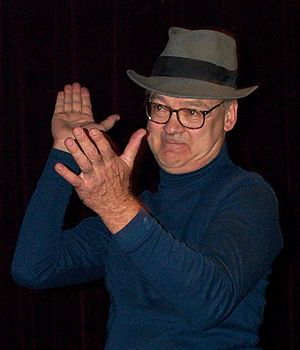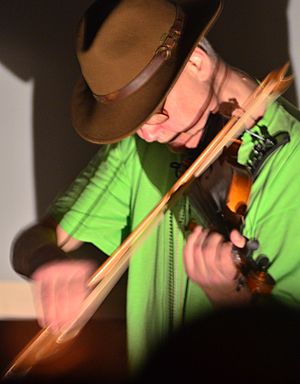Tony Conrad facts for kids
Quick facts for kids
Tony Conrad
|
|
|---|---|

Tony Conrad at the DeStijl/Freedom From Festival in Minneapolis-Saint Paul in October 2003.
|
|
| Born |
Anthony Schmalz Conrad
March 7, 1940 Concord, New Hampshire, U.S.
|
| Died | April 9, 2016 (aged 76) Cheektowaga, New York, U.S.
|
| Alma mater | Harvard University |
| Occupation | Filmmaker, musician, composer |
| Movement | Minimalism, drone music, structural film |
| Musical career | |
| Instruments | Violin |
| Years active | 1962–2016 |
| Labels | Table of the Elements, Caroline |
| Associated acts | Theatre of Eternal Music, The Primitives, Faust, John Cale, Charlemagne Palestine, Genesis Breyer P-Orridge, Laurie Spiegel, Angus MacLise, Keiji Haino, Jim O'Rourke, David Grubbs, C Spencer Yeh |
Anthony Schmalz Conrad (March 7, 1940 – April 9, 2016) was an American artist who worked with many different types of media. He was a filmmaker, musician, composer, sound artist, teacher, and writer. Starting in the early 1960s, he helped create new styles of music and film. These included drone music and structural film.
As a musician, he was important in the minimalist scene in New York. He played with a group called the Theatre of Eternal Music. He also became known for his 1966 film, The Flicker. Tony Conrad worked with many other artists throughout his career.
Contents
Tony Conrad's Life Story
Early Years and Education
Tony Conrad was born in Concord, New Hampshire. He grew up in Maryland and Virginia. His father helped design dazzle camouflage for the US Navy during World War II. This was a type of camouflage that made ships harder to target.
Tony learned to play the violin in high school. His teacher taught him about just intonation, a special way of tuning notes. He briefly studied violin at the Peabody Conservatory. In 1962, he graduated from Harvard University with a degree in Mathematics.
At Harvard, he learned about the ideas of famous composers like John Cage. After college, he worked as a computer programmer. This helped him develop computer skills. Soon, he became involved in the exciting New York City art scene.
Exploring Art in the 1960s
After moving to New York, Tony Conrad joined the Theatre of Eternal Music. This group was also called The Dream Syndicate. Other members included La Monte Young and John Cale. The group used just intonation and long, held sounds called drones. They called their music "dream music," which is now known as drone music.
Tony's math skills helped the group use precise musical intervals. He also encouraged them to use electronic sound equipment. Later, Tony left the group due to disagreements about who should get credit for their music.
In 1963, Tony joined Henry Flynt in his "anti-art" protests. They protested against art institutions in New York. They believed these places were too exclusive.
Tony Conrad and John Cale also played in a band called The Primitives. They were hired to back a singer named Lou Reed. Tony and John tuned their instruments to "Ostrich tuning." This meant all strings were tuned to the same pitch. This made them easier to play and fit their drone music style. After a few shows, the band broke up. John Cale and Lou Reed then formed The Velvet Underground. Tony Conrad indirectly helped name The Velvet Underground. Lou Reed and John Cale found a book called The Velvet Underground in Tony's old apartment. They liked the name and used it for their new band.
Creative Works in the 1970s
Tony Conrad's first music release was in 1972. It was a collaboration with the German krautrock band Faust. The album was called Outside the Dream Syndicate. It came out in 1973 and is still his most famous musical work. It is seen as a classic example of minimalist music and drone music.
In 1970, Tony released an early film called Coming Attractions. This film helped lead to the creation of the Environments series. This series featured recordings of natural sounds.
One of Tony's unique projects was Yellow Movies in 1973. He made twenty "movies" by painting black borders on large pieces of photographic paper. The idea was that the paper itself would slowly change color over many years. This aging process was the "movie." He wanted to make a film that would last fifty years.
In the 1970s, Tony started working with video and performance art. He became a professor at Antioch College in Ohio. Later, in 1976, he joined the University at Buffalo. He was part of a group of artists there who explored film, video, and performance.
Tony also created "performance films." For example, in Sukiyaki Film, he cooked Sukiyaki in front of an audience. He even cooked 16mm film along with the food. Then, he "projected" the cooked film onto a screen. He also made a piece called Pickled Film.
Later Life and Legacy
Later in his career, Tony Conrad composed many pieces for amplified violin. These works used special scales and tunings. Some of his releases include Early Minimalism Volume 1 and Slapping Pythagoras. He also released Four Violins (1964) and Fantastic Glissando. He even released old recordings by filmmaker Jack Smith.
Tony collaborated with many artists. These included Charlemagne Palestine and Genesis Breyer P-Orridge. He performed at the All Tomorrow's Parties festival in 2011. He also toured France in 2012 for the Sonic Protest festival. In 2013, he had his first solo art show in Italy.
Tony Conrad's art has been shown in many famous museums. These include the Museum of Modern Art and the Whitney Museum of American Art in New York City. His film The Flicker was part of a major exhibition at the Whitney Museum. One of his Yellow Paintings was also featured there.
Tony Conrad taught at the University at Buffalo from 1976 until his death. Some of his film students there formed the indie rock band Mercury Rev.
Tony Conrad's Passing
Tony Conrad passed away on April 9, 2016. He was at a hospice in Cheektowaga, New York. He had been battling prostate cancer.
Partial Discography
- Outside the Dream Syndicate (with Faust) (Caroline, 1973)
- Slapping Pythagoras (Table of the Elements, 1995)
- The Japanese Room at La Pagode / May (split with Gastr del Sol) (Table of the Elements, 1995)
- Four Violins (1964) (Table of the Elements, 1996)
- Early Minimalism Volume One (Table of the Elements, 1997)
- Inside the Dream Syndicate Volume I: Day of Niagara (with John Cale, Angus MacLise, La Monte Young, and Marian Zazeela) (Table of the Elements, [Recorded 1965] 2000)
- Fantastic Glissando (Table of the Elements, 2003)
- Joan of Arc (Table of the Elements, [Recorded 1968] 2006)
- An Aural Symbiotic Mystery (with Charlemagne Palestine) (Sub Rosa, 2006)
- Taking Issue (with Genesis Breyer P-Orridge) (Dais Records, 2009)
- Ten Years Alive on the Infinite Plain (Superior Viaduct, 2017)


